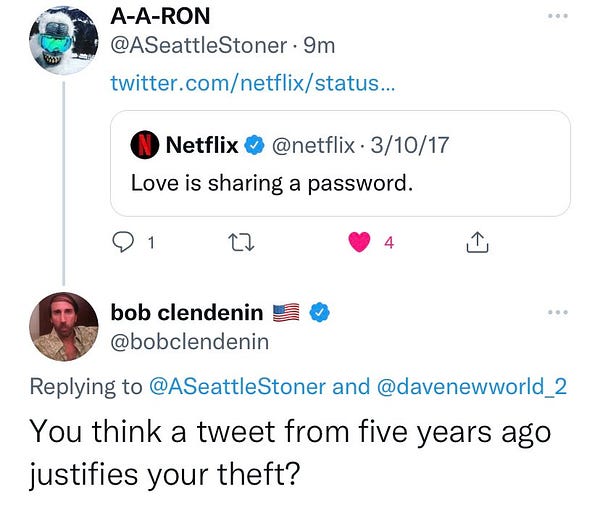CNN+ and the issues it exposes
What we used to call "TV" no longer exists, and networks still haven't figured it out
Sree’s newsletter is produced w/ Zach Peterson (@zachprague). I was so relieved by the French elections. One of the things that struck me is that Macron had the same approval rating as Biden does now, but won the election by this wide margin.
🗞 HOTLANTA! @Sree’s Sunday #NYTReadalong was an #AJCReadalong this week. Sunday mornings, 8:30-10 am ET, we read a print newspaper out loud on our Readalong video show, as we have six-plus years now. Usually, it’s the NYT, but we need to mix things up a bit sometimes, so Neil Parekh read the Atlanta Journal-Constitution with Ernie Suggs. Watch two years of our archives here. The Readalong is sponsored by Muck Rack. Interested in sponsorship opportunities? Email sree@digimentors.group and neil@digimentors.group.
📺 My Digimentors team is working with companies and nonprofits around the world to create virtual and hybrid events. We’ve worked on events for 50 people and 100,000. See our updated brochure. Please talk to us if you need events help or social media consulting (no project too small or too big): sree@digimentors.group and neil@digimentors.group.
📺 We’re looking for partners for #SMWKND 2022. Get involved with my flagship event since 2011. Get in touch with Linda Bernstein, conference chair (linda@digimentors.group), to discuss how we can work together. Details coming to smwknd.com.
***
CNN+ LASTED JUST FOUR WEEKS, but it tells me a lot about the modern media landscape.
This short thread from Wesley Lowery captures a lot of my thinking (and frustration) on the situation — especially this tweet:

The list of topflight journalists who have left legacy and established media outlets to “start something new for the news” is long, and CNN+ continued this trend. People like Audie Cornish, who left a distinguished career with NPR to go to CNN+, no doubt have a certain level of trust with people who know who she is. But, that is not an audience of scale for a paid streaming service, and there probably isn’t a major news audience that can support a stand-alone streaming news service (unless it’s Fox - and their offering is even less news-based than the terrible original).
This is a problem with the business side of the news industry, and it’s high time to realize that the people who have led the chaos-inducing expansion of streaming media have not, in fact, figured “it” out.
Netflix had a rough week as well, with its stock price tanking as it’s losing subscribers. The bosses have decided part of the problem is password sharing (which they used to encourage), instead of acknowledging that there may be an upper limit of the potential market or that their offerings aren’t as compelling as they used to be when they were the only game in town.



To me, The Great Streaming Wars of the 2010s have already been fought, and the consumer has suffered only defeat. The easy analysis is that the extremely-dispersed streaming environment has driven previously-syndicated shows and films back into the hands of the original owners, leading to streamer sprawl. This is obviously correct — why would NBC keep selling “The Office” when it can just bring it back in-house and put it behind a paywall?
The problem is that consumers are now required to micro-subscribe to sub-services that are all narrow in scope — and it all costs somewhere between $5-15 per month, per service. One of CNN’s big mistakes with CNN+ was that a subscription didn’t actually include access to CNN (for arcane cable-contract reasons), so viewers would still need a service that provides access to regular, flagship CNN. It’s not hard to see the issues here.
Now, there are hundreds of producers and writers looking for jobs in the news business, and consultants are dreaming up numbers that goad media executives into spending hundreds of millions of dollars on a doomed proposition — that people will sign up in droves for a mainstream news service that costs $6 per month.
The morning of the collapse, I asked Twitter what I should say to my students about CNN+. Among the replies was this somewhat optimistic note from my friend and TV anchor Joie Chen:

I do want news companies to continue to innovate, to try new things, but worry that CNN+’s collapse will mean fewer folks will spend the money to make that happen.
— Sree / Twitter | Instagram | LinkedIn | YouTube / Cameo
Thank you for your support of four years of this newsletter or a subset of that time. So grateful to you all!
A Message from Armory Square Ventures
On April 27, 2022, Upstate Capital Association of New York will bring together a thoughtful group of innovative leaders, entrepreneurs and investors to continue conversations on catalyzing startup formation and investing deliberately across all of New York State.
The conference will take place in Syracuse, and the focus will be on forging and growing investor and startup connections upstate and downstate. Seth Levine from Foundry Group and Elizabeth MacBride will keynote and discuss their new book, “The New Builders.”
Armory Square Ventures (ASV) Managing Partner Somak Chattopadhyay will moderate a conversation on venture and philanthropy with Meg O’Connell and Eric Allyn, both affiliated with the Allyn Family Foundation. ASV Partner Pia Sawhney joins a panel of judges at this year’s New York Business Plan Competition that day.
The competition’s top 6 student-led teams, solicited from a pool of applicants statewide, will compete for a total of $50,000 in cash prizes.
To register and learn more, visit Upstate Capital’s Venture NY event page.
Tech Tip w/ @newyorkbob: Tech Gadgets: Easy Come, There They Go
By Robert S. Anthony
Each week, veteran tech journalist Bob Anthony shares a tech tip you don’t want to miss. Follow him @newyorkbob.
As the old Joni Mitchell song goes “Don’t it always seem to go that you don’t know what you’ve got till it’s gone?” When it comes to tech products, you may not know what you’ve got because they’re sometimes gone before you know it.
The sudden demise of Warner Bros Discovery’s CNN+ streaming service less than a month after it debuted serves as a harsh reminder of how fragile tech ventures can be. It brings to mind the many tech products that came to market with trumpets and cymbals only to exit shortly afterward on sour notes.
In May 2010 Microsoft tested the smartphone market with the Kin ONE and Kin TWO, nifty looking units with slide-out keyboards and cool social media software. Consumers showed little appetite for the so-called “social phones” however, and by June 2010 the Kins had already hit the end of the road due to poor sales.
The 2010 Logitech Revue with Google TV, a set-top box with a wireless keyboard/controller, promised to deliver lots of online content to TVs while also controlling other home theater devices. Unfortunately poor reviews and kludgy software caused sales to tank to the point where they were actually negative: More units were being returned than were being sold. Of course such a business model doesn’t work and by 2011 the Revue was history.
In April 2011 the BlackBerry PlayBook, a well-built 7-inch tablet from Research in Motion, debuted with a 5-megapixel rear camera and dual mics which captured decent videos. Despite lots of promotion, very few apps were written for its proprietary operating system and it initially shipped without email or contact apps. PlayBook sales never challenged Apple’s iPad and by 2013 it was done.
When Samsung introduced the Galaxy Note 7 smartphone, an Android powerhouse, it was poised to be the tech star of the 2016 holiday shopping season. It had a 5.7-inch display, a smart stylus, a 12-megapixel rear camera and could survive 30 minutes in five feet of water.
Sales were brisk until units started igniting spontaneously. An internal design flaw didn’t allow for the normal expansion of its battery when it got warm. After the federal government banned it from airlines in October 2016, it was recalled worldwide.
While we applaud innovation and companies that take risks, remember that it’s always good to tread slowly toward the electronics store when it comes to Version One of anything. Be patient: Let the early birds do your beta testing.
Read Something
Distrust in institutions has been a hallmark of the political right since Ronald Reagan uttered his infamous “I’m from the government and I’m here to help” line — and that sentiment has migrated to other public institutions. It’s been depressing to see just how anti-school and anti-teacher the right has become, and seeing those numbers displayed so starkly is really something. Conservatives hate K-12 public schools and the very concept of university and it may end up being the death of the movement.
Watch Something
It’s been a year of loss in the comedy community, and Gilbert Gottfried will be missed. He may have the most famous/recognizable voice of all time…? This clip is Gottfried in the rarest of rare forms on Hollywood Squares, and it’s worth 5 minutes of your time.

👀 Did we miss anything? Make a mistake? Do you have an idea for anything we’re up to? Let’s collaborate! sree@sree.net and please connect w/ me: Twitter | Instagram | LinkedIn | YouTube / Cameo.







This is a crazy example of the problems leading to micro-subscribe. We are subscribers to three (count 'em, 3) PBS TV stations, and thus have access to three (count 'em, 3) PBS Passports. So during shutdown we decided that we wanted to re-watch "A Jewel in the Crown," and could not access it on PBS. We could get it through the Masterpiece Theater sub-channel on Amazon, which we did. So it was $5.99/mo until I culled my Amazon subscriptions two months ago. Yes, we watch a ton of old Masterpiece Theater productions. But why was this even necessary?